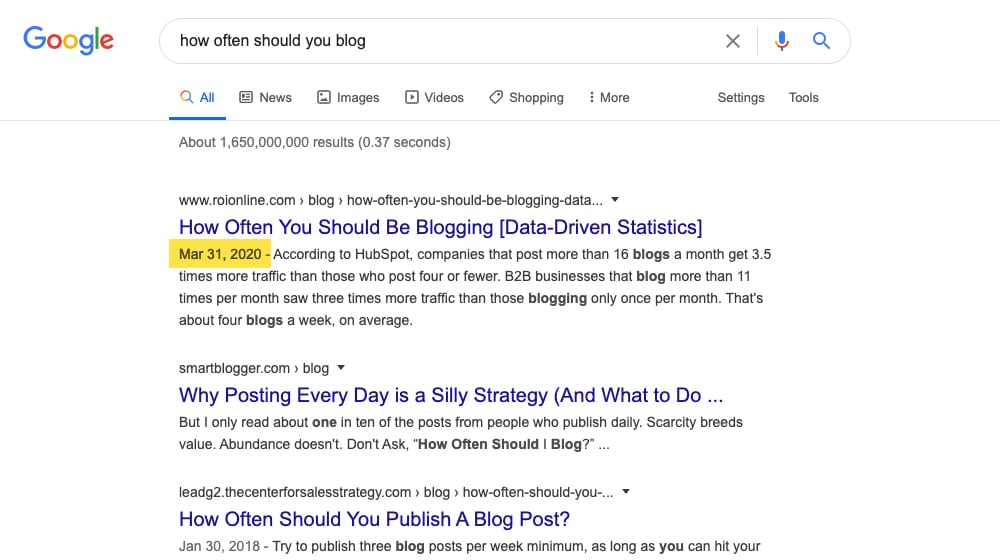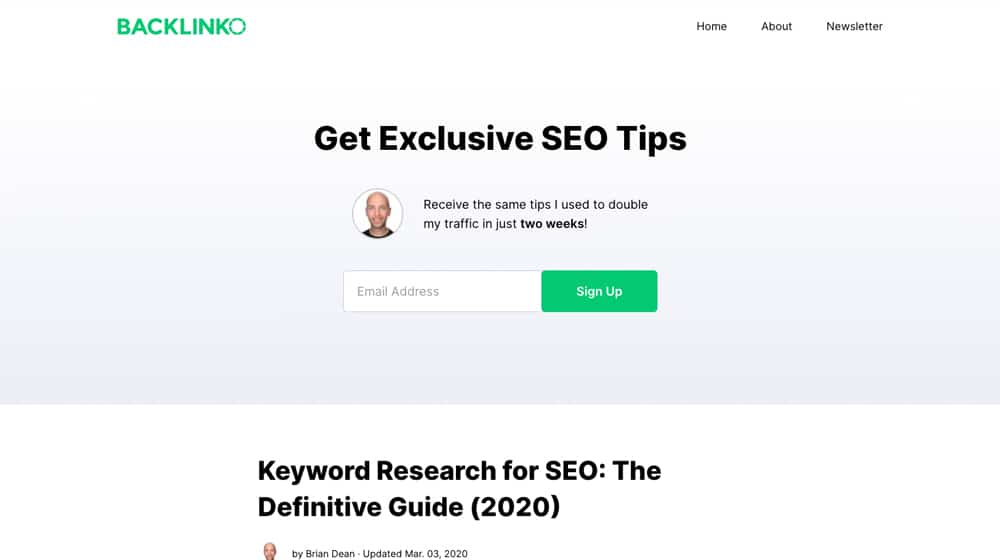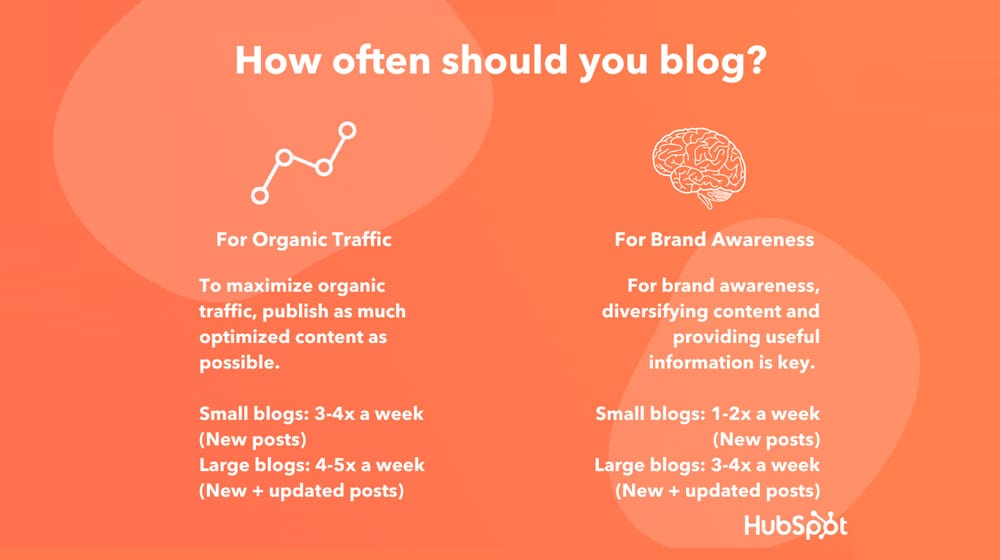The Truth About Blogging Frequency: It's Not Important

There are a lot of different factors that contribute to the success of a blog. Some of the biggest, as you may have seen circulated by marketers time and again, involve the mechanics of blogging at an upper level. Specifically, they are:
- You have to post high-quality blog posts.
- You have to post on a consistent schedule.
- You have to post frequently.
Unfortunately, many marketers have taken these three points and approach them out of order. This has led to a handful of myths circulating throughout the marketing world, holding many bloggers back from the success they deserve.
Myth: Google Demands New Content Daily
Google likes fresh content, but is it really that valuable? I would argue that it's not. After all, you can see dates on most entries in Google search results. Let's take a few examples.
Searching for "how often should you blog?" shows results from 2019, 2012, 2016, 2018, and a couple from 2020. Only one of those results on the first page was published within the last couple of weeks. That post, from ROI Online, actually had the publish date on their post updated. It was updated that recently, but if you look, there are comments from 2018. The actual article was posted two years ago, or more.

A counter-example would be something like a search for Bernie Sanders. For future reference, I'm writing this post the day after Bernie suspended his 2020 campaign in favor of the safety of voters during the pandemic. As such, other than the usual results like his website and Twitter accounts, every result was published less than a day ago.
This is the difference between trying to focus on evergreen topics and focusing on newsworthy topics. Evergreen topics stick around, showing up in Google search and providing value, for years after they are published. All of the news results for the second search there? None of them are going to show up in a week, let alone in a year. There will undoubtedly be more recent news to appear.
The fact is, while Google likes fresh content, it's not an imperative like many people think. It all comes from a misinterpretation of Google's desires.
Google attaches a particular kind of data flag to queries, called the QDF rating. This is a rating of how much the "Query Deserves Freshness". If the topic is newsworthy, they will more heavily prioritize more recently published content. If the query is more evergreen, they will prioritize higher quality, more popular content over fresher content.

Basically, Google just wants to make sure sites that it shows to people are active and cared for. They don't want to be promoting pages on a site that isn't kept up-to-date, if they can avoid it. Two blogs, alike in content, one abandoned and one kept up to date, will show the one kept active pulling ahead in the rankings.
The trap people fall into here is quantity over quality. You'll see me harp on this a lot throughout this post, actually, because it's such a common problem. Google prefers more content over less content, but they prefer better content over worse content even more.
This is also why a lot of the best blogs out there have a large number of writers working for them. The site itself might publish a new blog post every single day, but each individual writer is only writing 1-2 per month.
Myth: Your Readers Demand New Content
Alright, so Google doesn't demand new content every day, but what about your readers? These days, we're all conditioned to want new, fresh content delivered directly to our faces every second of every day. Facebook's feed scrolls endlessly to show you new stuff. Twitter is there with a new hot take every .03 seconds. Reddit's front page cycles fast enough that if you don't open something interesting in a new tab immediately, you might never see it again.
That's the thing, though. All of those sites are actually aggregators. They pull content from other sources, including your blog. Your blog is not the place people hang out to see new content on an ongoing basis.

If you like, you can run a survey with your audience. Ask them a simple question: how often do they check your site? My guess is the most popular answer is going to be something like "when I see a post from you on Facebook" or "when I'm searching for a topic and your site comes up." Some groups may have a dedicated following on RSS or Atom feeds, I suppose, and some might compulsively check your site every morning just hoping for new content, but they're the exception to the rule.
Most sites get their traffic from referrals, either from Google search (which, as I noted above, will happily give users relevant content from five years ago), or from social media. Your blog doesn't need to be as active as long as your social media is.
Myth: Writing More Helps Improve Your Posts
This one is kind of both a myth and a fact. Writing is a skill. Writing blog posts is a subset of that skill set. If you want to write high-quality blog posts, you need to practice. I've been doing it for years, and I still wouldn't consider myself among the top dogs in the industry.
The problem comes when you're "practicing" without actually practicing anything. Many people find that rather than actually practicing and improving, they fall into a rut. You end up writing with the same analogies, on the same topics, with a "just get it done" level of quality, and you don't ever really improve.
Actual practice requires introspection. It requires putting thought into what's holding you back and consciously making changes to push past those obstacles. You don't get that if all you're doing is writing for the sake of writing.
Myth: If You Write It They Will Come
A lot of people have used the Field of Dreams analogy with blogging over the last decade, and frankly, it's starting to get a little dated. I would bet that a lot of marketers only even know of the reference as a reference and have never seen the source material by this point.

The point is, just because you're writing a blog doesn't mean it's going to do anything for you. There's a lot more to successful blogging than just writing and publishing, even if you're keeping up with your consistency, frequency, and quality. A huge amount of your success relies on you promoting your blog posts. Without links, without social media, without cross-linking and commenting and becoming part of a community, all you're doing is talking to yourself. The rest relies on picking higher volume topics that will actually yield traffic, and steering your visitors to something after they read your article (subscribing, buying something, etc)
We create blog content that converts - not just for ourselves, but for our clients, too.
We pick blog topics like hedge funds pick stocks. Then, we create articles that are 10x better to earn the top spot.
Content marketing has two ingredients - content and marketing. We've earned our black belts in both.
What Data Says
One thing we can do is look at what actual data shows for blogging frequency and relative success. I don't personally have access to enough websites to make any reasonably accurate study, but I don't have to; other people already have.
The fact is, anything can work if you approach it at the right angle. The Huffington Post got its start publishing a new blog post once a minute when they were starting out. This massive flood of content meant that they went from nothing to a common name in a matter of weeks.
On the other side of the coin, you have people like Brian Dean of Backlinko fame. He publishes a new blog post, on average, 2-3 times per month. Yet every single post he publishes is huge, high-quality, and worth citing for its value.

Both sites are great in their own ways. They're two different, valid approaches to the problem of getting visibility online. One goes for volume, saturation, and time-sensitive content they can safely discard or ignore once its purpose has been served. The other focuses on every piece as a skyscraper of evergreen content and has built up a huge resource because of it.
What You Should Really Do
With all of the above in mind, what should you actually be doing? Well, if you look at those three bullet points again:
- You have to post high-quality blog posts.
- You have to post on a consistent schedule.
- You have to post frequently.
This isn't a random order for this list. This is, in fact, the order I believe you should focus on them in.

Focus on quality above all else. If you can only write one blog post per month, but that blog post is 4,000 words long with tons of original research, deep conclusions, and actionable advice for your target audience, it's going to do amazingly well. I would argue that it will do better than splitting the same post into two or four and publishing each section throughout the month, even.
Once you have your quality down, you can start ramping up production. Consistency is key here; if you only publish once a month, try to make it at the same time each month. When you make the jump to twice each month, make it a regular cycle, like on the 1st and the 15th, for example.
Once you have consistency down without breaking your quality levels, you can focus more on volume. The biggest problem I see with marketers, old and new, is publishing far too much content when most of it simply isn't worthwhile.
Think back to the 80/20 rule:
The Pareto principle (also known as the 80/20 rule, the law of the vital few, or the principle of factor sparsity) states that, for many events, roughly 80% of the effects come from 20% of the causes.
If you apply the Pareto principle, 80% of the value you get from your blog will come from 20% of your posts. Funny enough, this is very consistent with my own findings after auditing hundreds of different blogs. All the best marketers out there has figured out what makes the 20% of those posts high-quality and have simply stopped writing the other 80% of the other posts. If that means a lower frequency, so be it.
At the end of the day, it's actually better to focus less on writing and more on promotion. Instead of writing a post every single weekday, cut back to 2-3 per week and focus on promoting those posts. Instead of writing 2-3 times per week, write once a week and promote the heck out of that post. Focus on writing great content and promoting it, rather than trying to flood the internet with your content and hoping saturation will do the job for you.
Decide Your Goals
Determining how you want to approach content marketing is the key to developing a successful plan. The first thing you need to do, then, is deciding what your goals are.
Do you want brand awareness? Do you want organic traffic? Do you want to be an authority people turn to for evergreen information? Do you want to be a hub of cutting edge news? You can do these things, but you need to focus on them properly.
According to Hubspot, if you want to focus on maximizing your organic traffic, you want to publish new posts around 3-4 times per week. This publishes a reasonable amount of content. Once you've grown to a decent size and have a sizable back catalog of blog posts, you can start adding post updates to the list and bump that to 4-5 times per week.

The reasoning here is that each post is a chance for Google to send traffic your way. The more posts you have (that are high enough in quality to rank well in Google's search), the more opportunities you have for people to find you and click through.
If you're focusing on brand awareness instead, you should focus on a smaller number of higher quality posts. 1-2 posts per week for small blogs allows you to spend several days focusing on each individual post to make it the best that it can be, and you can have the best possible chance to go viral with it. Once you grow to a sufficient size, you can add updated posts, and bump that up to 3-4 posts per week.
Of course, all of these numbers can be adjusted based on your resources and your capabilities. You could, for example, publish a new high-quality post every single day of the week, if you're paying to have high-quality ghostwriters create that content. If you have multiple writers on staff, you can give each of them individual assignments and still have weekly high-quality posts.
Quality really is the most important factor here. It doesn't matter what your goal is, you need high-quality content. Google has been stressing this more every year since Panda in 2011, and it's not likely to change gears any time soon.






September 03, 2020 at 7:18 am
This has bugged me for quite some time now. I have been creating blog posts in high frequency but it does not get good results on data. "focus less on writing and more on promotion" - This is the answer I am looking for and of course less on writing but more quality. Thank you for this James!
September 03, 2020 at 4:52 pm
Hey Scott, thanks for the kind words!
I also tell my clients, if you wrote a great enough blog post, it sort of promotes itself. You can attract millions of links and shares without ever focusing on link building or social media, if your content is good enough. Blogging frequency definitely takes a back seat to quality.
I still get asked this question to this day, so I'm glad I wrote a post about it 🙂 thanks again for stopping by!
March 11, 2021 at 6:55 am
Hey man! So you think having 1 blog a week or at least 2x a month as long as its evergreen content is okay?
March 12, 2021 at 1:21 pm
Hi Theron!
Absolutely. If you find yourself wanting to grow a little faster or if you have extra free time, fit in an extra article here or there. I think one blog per week is a great way to start growing and get your proof of concept with blogging.
With lower volumes, quality and topic selection is very important so you're ensuring every post that you publish is a success. Check out our process page on topic selection, I think it will help you and give you an idea of what is required.
April 26, 2021 at 6:35 am
Very helpful. Usually, in articles like this, I learn one or two things, but I learned several new things about how content is treated.
I’ve always heard the “quality over quantity” kind of advice, and now I understand why.
Thanks, James.
Best,
Thomas
April 29, 2021 at 6:30 pm
Hey Thomas!
That means a lot, I appreciate it!
Here's the "Part 2" to this article that I think you'll like as well:
https://www.contentpowered.com/blog/mix-long-short-blog/
It gets more into the technical differences between low-quality and high-quality content. It's hard to crank out a ton of high-quality content, so usually (but not always) a high frequency of content production results in a drop in quality.
November 30, 2021 at 1:09 am
You make a great point with comparing evergreen topics to newsworthy topics. I did a Google search of Bernie Sanders as I read this and you’re right, more recent news are displayed and it’s a struggle to find news on his withdrawal without adding keywords to the search.
I also really like what you said to Scott, writing a good enough blog post really does promote itself. I’ve personally found myself sharing quality articles countless of times to my friends. Quality should indeed be the main focus. Thanks for sharing this!
December 01, 2021 at 5:41 pm
Hey Phil!
Thanks for that, and I'm glad it was useful to you too. If a blog post isn't good enough to share with friends then Google can probably tell it isn't good enough to share with people, either.
I have clients that occasionally tell me they read my blog posts and it makes me excited - I put so much time into them, so it's gratifying to hear that they're being read and that they're acting on the advice they're reading. I can only hope the same happens for all of my readers!
July 21, 2022 at 5:15 pm
Amen to this. It's not about the frequency but the consistency.
July 21, 2022 at 7:12 pm
The ultimate marathon! I'll never stop 🙂